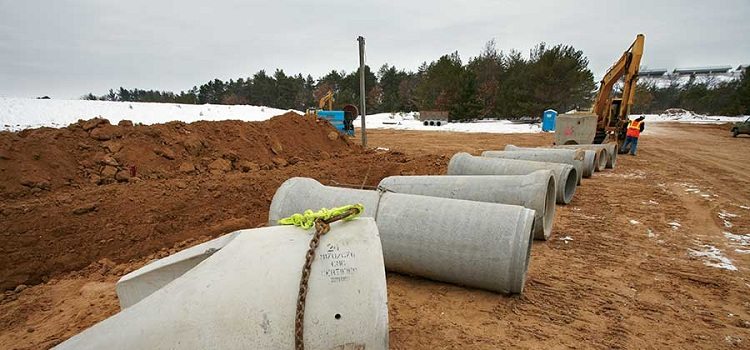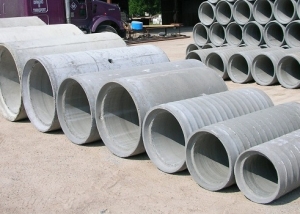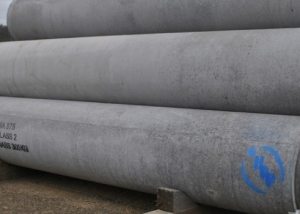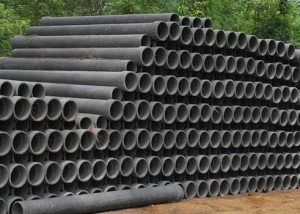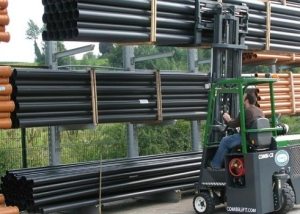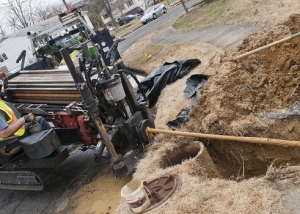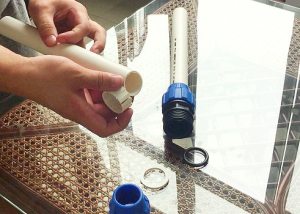Asbestos cement is a fairly durable material, the composition of which is represented by cement reinforced with asbestos fibers. Asbestos is a naturally occurring silicate (magnesium hydrosilicate). The prevalence of asbestos-cement pipelines can be explained by the excellent qualities of this material: it is flame retardant, does not break down due to prolonged contact with a humid environment, and has high mechanical strength.
Content
Asbestos-cement pipe - what is it?
Depending on the type of structure and the amount of impurities in the composition, asbestos hydrosilicate has several varieties:
- chrysotile or white asbestos;
- amphibiol asbestos.
This silicate material is neither toxic nor radioactive. Being in close proximity with asbestos and working with it is safe for humans, a serious danger is the ingress of asbestos dust into the respiratory tract. These risks, leading to the development of malignant neoplasms, require the presence of special protective devices for the employee.
The production of asbestos-cement pipe is as follows: the asbestos pipe undergoes chemical bonding of silicate fibers to cement (this process is called packing in a cement matrix).
Important! As a result of this procedure, silicate acquires new properties and becomes absolutely safe for future use.
The process of manufacturing products from reinforced asbestos is carried out in a clearly established sequence:
- with the help of crushing drums, asbestos is crushed to the smallest separated fibers;
- a dry mixture is formed in certain proportions: 85% of Portland cement and only 15% of asbestos are present in it. The mixture is diluted with water to the desired consistency;
- the resulting composition is poured into the centrifuge. When the apparatus rotates, the mixture settles on the walls, as a result of which a seamless design of ideal geometry is obtained;
- the pipe blank is placed in a steam chamber, where asbestos cement gains maximum strength under the influence of high temperatures.
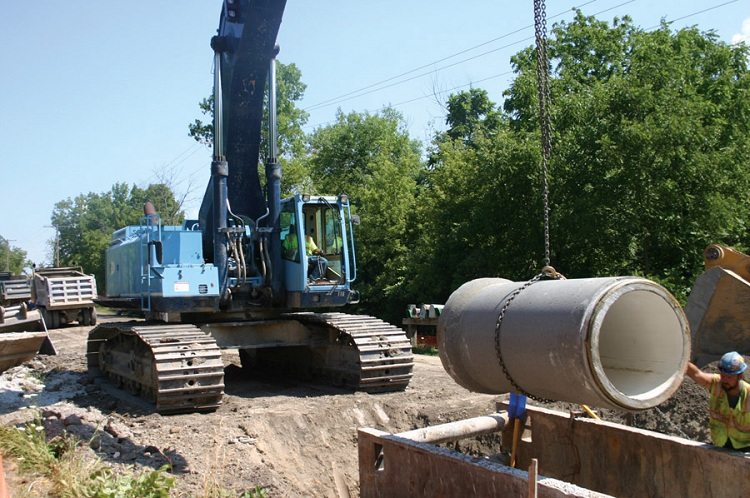
Thanks to modern technology for the production of asbestos-cement pipes, working with them is safe for human health
An asbestos-cement pipeline manufactured in accordance with all standards eliminates the release of hazardous asbestos dust. Asbestos cement does not belong to the category of carcinogenic materials and is not able to change the composition of the water circulating through the pipeline.
Scope of asbestos-cement pipe
Asbestos cement pipes are considered one of the most sought-after products in many construction fields. Structures from this universal material are used even under difficult operating conditions in which the shelf life of a metal pipeline would be no more than 2-3 years. The most common areas of application are:
- sanitary or technical water supply systems;
- drainage systems, storm drains, channelless installation of waterproofing systems;
- pressureless sewers;
- water wells - as casing pipes;
- columnar and bored foundations - as formwork;
- ventilation systems and chimneys;
- decorative constructions.
To simplify the connection of asbestos-cement pipes, a sufficiently large number of mounting devices exist. Among the positive characteristics that influenced the widespread prevalence of pipe pipes, we can note:
- lack of rotting and corrosion from prolonged contact with water, lack of need for waterproofing;
- lack of influence of biological factors: asbestos pipe is not damaged by rodents, it is resistant to aggressive substances from the soil;
- the inner surface of the product does not overgrow with sludge, mineral deposits do not occur on it;
- dielectric properties of the material, the ability to withstand electrochemical corrosion resulting from the influence of stray currents;
- pipes have low thermal conductivity: heat loss is minimal even in the absence of thermal insulation;
- high mechanical impact strength, durability;
- the relatively low cost of products, making their use economical even when laying large-scale pipelines.
Also, asbestos cement pipe can be used in the household. Sometimes these products are used as ceilings for garages or small hangars, serve as simple feeders for livestock.
An overview of the diameters of asbestos-cement pipes
At production plants, asbestos-cement pipes are divided into two categories: pressure pipes for water supply and pressureless pipes for sewers. Products from the first group are manufactured in accordance with GOST 539-59, from the second - according to the standards of GOST 1839-48.
The diameters of pressure pipes made of asbestos cement are presented in table No. 1.
Table 1
| Doo | Outside Diameter, Grades | Inner Diameter, Grades | Length of the product | |||
| VT3 | VT6 | VT9 - VT12 | VT3 - VT9 | VT12 | ||
| 50 | 68 | 50 | – | – | ||
| 75 | 93 | 75 | 2950 | |||
| 100 | 118 | 122 | 100 | – | ||
| 125 | 137 | 139 | 142 | 119 | 2950 | |
| 150 | 161 | 163 | 168 | 141 | 135 | 3950 |
| 200 | 209 | 217 | 224 | 189 | 181 | – |
| 250 | 259 | 265 | 274 | 235 | 226 | |
| 300 | 305 | 314 | 324 | 279 | 270 | 3950 |
| 350 | 352 | 361 | 373 | 322 | 012 | – |
| 400 | 402 | 414 | 427 | 368 | 356 | |
| 500 | 498 | 511 | 528 | 456 | 441 | |
For sewer systems of a household scale (drainage of one house, cottages), small diameter pipes are used. The general network, where the effluents of the whole district, village, etc. are reduced, requires the laying of large-sized products with high throughput. The selection of pipe sizes should be carried out in accordance with norms and standards, because non-compliance of the pipe diameter with the volume of drains will inevitably lead to malfunctions in the network and all the ensuing problems.
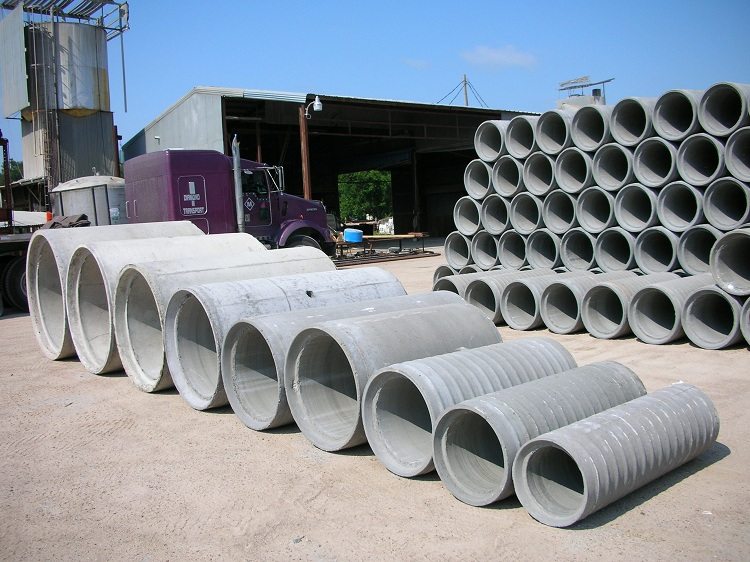
Such pipes are produced in a variety of diameters, so you can build both household and industrial pipelines from them.
Calculations should be carried out at the design stage of the highway and strictly follow the approved plan for the procurement of materials and installation. This applies to any type of sewage system - both pressure and gravity.
The diameters of pressure-free asbestos-cement pipes are presented in table No. 2.
table 2
| Doo | Outside diameter;
Marginal deviations |
Inner diameter | Length of the product;
Tolerances |
| 100 | 116
+2-2,5 |
100 | – |
| 125 | 139
+2-2,5 |
123 | 2950
-50 |
| 150 | 165
+2-2,5 |
147 | – |
| 200 | 215
+2-2,5 |
195 | |
| 250 | 265
+2-2,5 |
243 | |
| 300 | 315
+2-2,5-3 |
291 | |
| 350 | 364
+2-2,5-3 |
338 | 3925
-50 |
| 400 | 414
+2-2,5-3 |
386 | – |
| 500 | 514
+2-2,5-3 |
482 | |
| 600 | 612
+2-2,5-3 |
576 |
Installation, connection of asbestos-cement pipes
Quality installation of products from reinforced asbestos is performed in this way:
- the ends of the pipes are turned on the outside: this is necessary to obtain a rough surface and accurate size;
- installation is done using couplings. These devices have grooves on the inner surface filled with durable rubber or rubber rings. Cuffs ensure proper tightness of the joint.
- at the junction of the asbestos-cement pipe and the connecting part, a gap is observed, the value of which is at least 3 degrees. This allows you to withstand linear expansion, as well as to carry out installation without the use of temperature compensators.
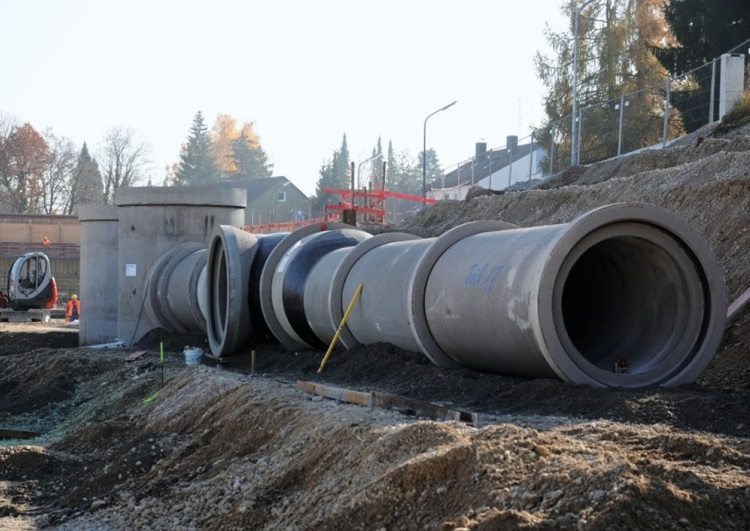
The connection of asbestos-cement pipes requires the use of o-rings, on which the tightness of the system depends
It is interesting! Asbestos cement pipeline can have only a direct configuration. Shaped elements (crosses, tees, etc.) are not made from this material, although this is technologically possible. The reason for the lack of asbestos-cement shaped parts on the market is their low strength, which appears due to the random arrangement of silicate fibers.
If there are branches or bends in the structure, cast-iron or steel fittings are used. They are fixed with flanges with gaskets.
Features of the certificate for asbestos-cement pipe
Like any product intended for the transport of drinking water, asbestos-cement pipe is allowed for mass sale only with a certificate confirming compliance with applicable hygiene and technical standards. The certificate of conformity for this type of product is issued by accredited bodies. The main reason for mandatory certification is the need to confirm that the level of radionuclides in natural material (asbestos) is within an acceptable limit.
The certificate is a documentary guarantee of the complete radiation safety of asbestos cement pipes. Studies for possible radioactive effects are carried out in laboratories equipped with specially designed equipment. These laboratories are also subject to regular verification and accreditation.
The certificate is issued after passing a series of tests. The certificate contains all the data that was obtained during the research, as well as the final conclusion. The formal part of the document is compiled according to a certain scheme developed and approved by applicable law.
Certified asbestos-cement pipes made in the established technological order are completely safe for humans and the environment. In some cases, analogues that can also perform the tasks in the same high quality do not exist in cement-asbestos pressure or pressureless pipes.
